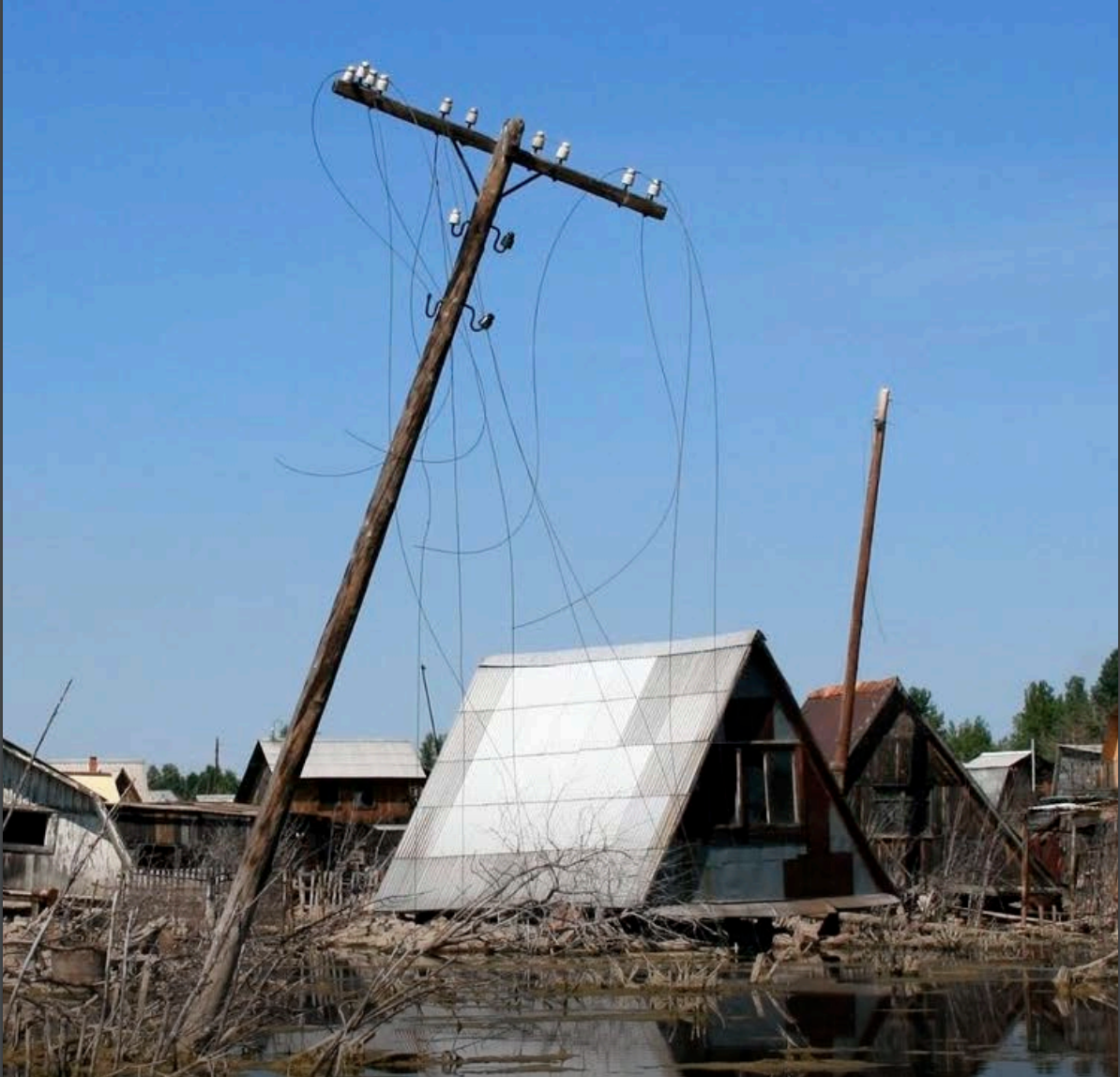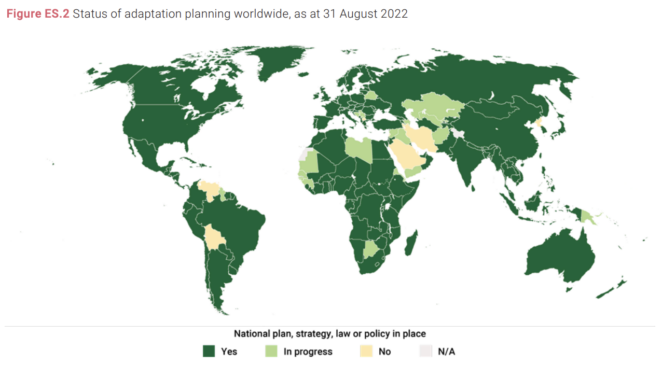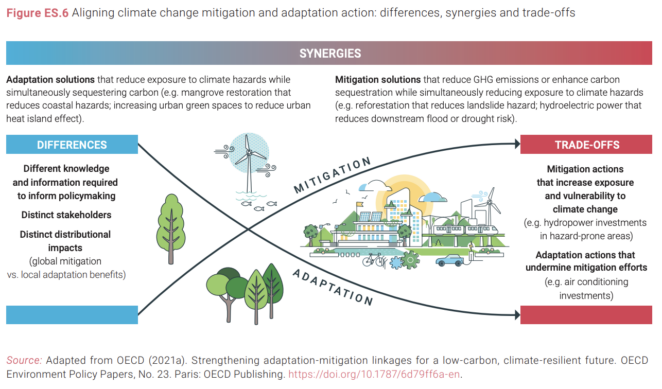UNEP Adaptation Gap Report 2022

Introduction
Climate change is landing blow after blow upon humanity, as we saw time and again throughout 2022: most viscerally in the catastrophic floods that put much of Pakistan under water. These are the kinds of climate impacts we are suffering at only 1.1°C above pre-industrial temperatures. We are heading for much higher temperatures: 2.8°C by the end of the century, based on current policies.
The 2022 edition of the UNEP Adaptation Gap Report builds on the previous years report. The report looks at progress in planning, financing and implementing adaptation actions. At least 84 per cent of Parties to the UN Framework Convention on Climate Change (UNFCCC) have established adaptation plans, strategies, laws and policies – up 5 per cent from the previous year. The instruments are getting better at prioritizing disadvantaged groups, such as Indigenous peoples.
However, financing to turn these plans and strategies into action isn’t following. International adaptation finance flows to developing countries are 5-10 times below estimated needs and the gap is widening. Estimated annual adaptation needs are USD 160-340 billion by 2030 and USD 315-565 billion by 2050.
Implementation of adaptation actions – concentrated in agriculture, water, ecosystems and cross-cutting sectors – is increasing. However, without a step change in support, adaptation actions could be outstripped by accelerating climate risks, which would further widen the adaptation implementation gap.
The report looks at the benefits of prioritizing actions that both reduce greenhouse gas emissions and help communities adapt, such as nature-based solutions, and calls for countries to step up funding and implementation of adaptation actions. Additionally, the report discusses adaptation effectiveness and looks at adaptation-mitigation linkages and co-benefits.
This weADAPT article is an abridged version of the original text, which can be downloaded from the right-hand column. Please access the original text for more detail, research purposes, full references, or to quote text.
Methodology
Since 2020, the AGR has delivered regular assessments of adaptation efforts globally (box 1.2) in order to help answer three linked questions:
1. What has been done to adapt until today?
2. To what extent have climate risks been reduced?
3. Depending on the temperature trajectory, which is a function of mitigation action, are current adaptation efforts likely to reduce future climate risks?
The AGR2022 builds on national-level data from governments (for example, documents submitted under the UNFCCC), as well as project-level information from the databases of multilateral organizations and the OECD, and peer-reviewed scientific literature focusing on climate impacts and adaptation occurring at various scales (global to local).
The three aforementioned questions (see chapter 6) raise important methodological issues and data challenges that the AGR attempts to address by:
- Focusing on national-level efforts and international cooperation, using information from policy documents, international agencies and donors.
- Focusing on three core dimensions of assessing adaptation progress at the global level: planning (chapter 2), finance (chapter 3) and implementation (chapter 4).
- Assessing adaptation outputs (i.e. processes, products and services) and outcomes (i.e. the effects of adaptation on risk reduction) in both quantitative and qualitative terms.
- Synthesizing knowledge on a specific topic such as nature-based solutions in the 2020 edition of the AGR (UNEP 2021c) and, in this year’s report, on the effectiveness of adaptation (chapter 5). The AGR2022 understands effectiveness in adaptation as actions that reduce climate risks, building on the IPCC’s climate risk framework (IPCC 2022), by reducing exposure and/or vulnerability (in the sense of sensitivity) to climate hazards
Lastly, as a new feature, this report includes an analysis of the interlinkages that exist between adaptation and mitigation. Adaptation–mitigation interlinkages are discussed across the planning, finance and implementation chapters and synthesized in chapter 6. The cross-chapter analysis focuses on the direct synergies and trade-offs that exist between adaptation and mitigation as they apply to adaptation planning, financing and implementation.
The analysis included in this report highlights opportunities to reflect on synergies and trade-offs between climate risk reduction, GHG emissions reduction and sustainable development and, in this way, support the design of net-zero climate-resilient development.
Key Messages
Some key findings from the report are listed below. For the complete findings, see the full report (downloadable from the righthand side).
- Climate risks are increasing as global warming accelerates. Strong mitigation and adaptation are both key to avoiding hard adaptation limits.
- Climate impacts are increasing across the globe. A multi-year drought in the Horn of Africa, unprecedented flooding in South Asia, and severe summer heat and record-breaking droughts across multiple regions of the northern hemisphere, among others, point to mounting and ever-increasing climate risks. According to the recent Intergovernmental Panel on Climate Change (IPCC) Working Group II Sixth Assessment Report (IPCC WGII AR6), the world will face severe climate risks before the end of this century, even under low-emission scenarios (figure ES.1).
- Ambitious, accelerated action to adapt to climate change is therefore paramount, together with strong mitigation efforts. However, even ambitious investment in adaptation cannot fully prevent climate change related impacts. Hence, dealing with losses and damages cannot be avoided and must be addressed adequately at the United Nations Framework Convention on Climate Change (UNFCCC) and at national levels.
- Adaptation must not be sidelined because of large-scale, non-climate and compounding factors.
- The war in Ukraine, global supply shortages and the global COVID-19 pandemic have all contributed to an evolving energy and food security crisis, with the cost of living as well as inflation surging in many countries across the world. However, unprecedented political will and many more longterm investments in adaptation are urgently needed to avoid the adaptation gap from widening.
- It is critical that the international climate community build on the Glasgow Climate Pact, agreed during the twenty-sixth session of the United Nations Climate Change Conference of the Parties to the UNFCCC (COP 26) in 2021, and deepen collective commitments on net-zero, adaptation, climate finance, and loss and damage.
- Global efforts in adaptation planning, financing and implementation continue to make incremental progress but fail to keep pace with increasing climate risks.
- This calls for groundbreaking acceleration in scientific research, innovative planning, more and better finance and implementation, increased monitoring and evaluation, and deeper international cooperation. Current processes under the United Nations climate negotiations, including the Glasgow–Sharm el-Sheikh work programme on the global goal on adaptation and the global stocktake, present an important opportunity to act upon the conclusions of this report and the IPCC WGII AR6.
- More than eight out of 10 countries now have at least one national adaptation planning instrument, and they are getting better and becoming more inclusive of disadvantaged groups.
- However, the majority of these targets do not capture the outcomes of adaptation action, such as the degree to which people and ecosystems are more resilient or less vulnerable to climate change.
- Countries are also increasing the implementability of adaptation planning instruments by defining objectives, determining time frames, considering future climate change, strengthening the science base, and improving the capacity and partnerships needed to ensure effective implementation.

- The adaptation finance gap in developing countries is likely five to 10 times greater than current international adaptation finance flows and continues to widen.
- International adaptation finance to developing countries continues to rise, reaching US$28.6 billion in 2020. This represents a 34 per cent share of total climate finance to developing countries in 2020 and is a 4 per cent increase from 2019. Combined adaptation and mitigation finance flows in 2020 fell at least US$17 billion short of the US$100 billion pledged to developing countries, even by climate finance providers’ own accounting. If the annual increase from 2019 persisted in the coming years, the US$100 billion target would not be met until 2025. This calls for significant acceleration in adaptation finance, especially if doubling of 2019 finance flows by 2025 is to be met, as the Glasgow Climate Pact urges.
- Adaptation implementation is increasing but not keeping up with climate impacts.
- Actions are concentrated in the agriculture, water, ecosystems and cross-cutting sectors and primarily address rainfall variability, drought and flooding. However, without a step change in financial support, adaptation actions could be outstripped by accelerating climate impacts, which would further widen the adaptation implementation gap.
- Current adaptation practice falls woefully short of what is required, but following best practices in adaptation planning and implementation can improve effectiveness.
- Adaptation actions remain largely incremental in nature, typically do not address future climate change, and may reinforce existing vulnerabilities or introduce new risks, particularly for the most vulnerable.
- Considering interlinkages of adaptation and mitigation action from the outset in planning, finance and implementation can enhance co-benefits.
- Strong mitigation action is needed to limit global warming to 1.5°C above pre-industrial levels and avoid reaching most hard adaptation limits. Enhanced adaptation support is needed to minimize climate impacts, and more losses and damages will occur if mitigation is insufficiently ambitious. Given this interrelationship and to enhance synergies while limiting trade-offs, this report devotes a section in the planning, finance and implementation chapters to adaptation–mitigation interlinkages.
- Taking adaptation and mitigation jointly into account in planning, finance and implementation enhances opportunities for co-benefits, including ancillary and non market benefits, and limits trade-offs and maladaptation (such as hydropower reducing food security or irrigation increasing energy consumption). Moreover, some climate solutions effectively reduce climate risk and contribute to mitigation simultaneously (figure ES.6).
- However, while nature-based solutions such as planting and conserving mangroves, restoring salt marshes or protecting peatlands effectively reduce climate risks and remove carbon from the atmosphere, accelerating climate change is also heavily affecting their ability to provide these climate services. Data from planning, finance and implementation show that adaptation–mitigation co-benefits are mainly sought in the agriculture, forestry, ecosystems, water and energy sectors. However, possible barriers, trade-offs and risks are frequently missed, and adaptation and mitigation actions are often implemented independent of each other. Addressing these shortcomings will be important to contribute to the Paris Agreement’s article 2.1(c) goal of making finance flows consistent with low greenhouse gas (GHG) emissions and climate-resilient development

Outcomes and Impacts
The UNEP Adaptation Report 2022 finds that, despite positive signs, we must do much more towards net-zero climate-resilient development:
- Avoiding hard adaptation limits requires the urgent scaling-up of mitigation and for adaptation to go beyond incremental change.
- Although efforts in adaptation planning, finance and implementation are continuing to increase, significant acceleration and shifts in scale are needed to avoid the adaptation gaps from widening further.
- Current adaptation practice falls woefully short of what is required, and following best practices in adaptation planning and implementation is needed to improve effectiveness.
- Despite the potential for substantial co-benefits to be realized when considering adaptation-mitigation interlinkages from the outset, more must be done to overcome silos and avoid potential trade-offs.
- Large-scale, non-climate and compounding factors continue to jeopardize adaptation investments and outcomes, and strong political will is needed for the international climate community to build on the Glasgow Climate Pact, agreed during COP 26 in 2021, and to deepen collective commitments on net-zero, adaptation, climate finance, and loss and damage.
In the foreword of the report Inger Andersen, Executive Director of UNEP states: “We cannot use other global crises as excuses for inaction. Yes, the war in Ukraine, global supply shortages and the COVID-19 pandemic have all contributed to an energy and food security crisis. Costs of living are going through the roof across the world. But the temperature ranges we are currently looking at over the decades to come – even with mitigation – will turn the climate impacts we are seeing now into knockout blows for generations to come. We must get serious about adapting to climate change. And we must do it now.”
Suggested Citation:
United Nations Environment Programme (2022). Adaptation Gap Report 2022: Too Little, Too Slow – Climate adaptation failure puts world at risk. Nairobi. https://www.unep.org/adaptation-gap-report-2022
Related resources
- Adaptation Gap Report 2020
- The IPCC's 6th Assessment Report: Impacts, Adaptation, and Vulnerability - Summary for Policymakers
- ZEROing IN on this critical decade for climate: Insights from the latest IPCC reports on the Paris Agreement, 1.5°C, and climate
- Mapping the Evolution and Current Trends in Climate Change Adaptation Science
(0) Comments
There is no content